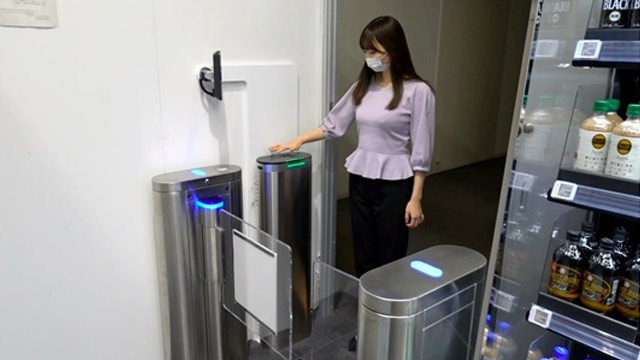Fujitsu Laboratories, Ltd. has announced the development of a new multi-factor biometric authentication technology to deliver an innovative shopping experience for the “New Normal” era, combining non-contact biometrics that filter the verification target through facial data with identification performed via palm vein recognition. This technology enables identification with greater than 99% accuracy even when the user wears a mask, and will be showcased at a concept cashless Lawson convenience store at the Fujitsu Technology Square office in Shin-Kawasaki, Japan, for a field trial starting from January 2021.
Users wearing masks present challenges to conventional facial recognition filtering technologies because a large part of the face is obscured, rendering authentication impossible in some cases. With the newly developed technology, however, differences in the appearance depending on the presence or absence of the mask can be absorbed by generating a composite image that combines the mask with the face image and training the model, achieving filtering accuracy of greater than 99%, or equivalent to that without a mask. Fujitsu has additionally enhanced its existing palm vein authentication sensor technology by improving the user interface so that users know how close to position their hand from the sensor for smooth authentication. This technology was ranked 6th amongst 147 participating global vendors and 1st place amongst Japanese vendors in the face authentication vendor test conducted by the United States’ National Institute of Standards and Technology (NIST).
Development Background
In recent years, the use of biometric authentication technologies has been increasing, including in areas like the processing of payments at brick-and-mortar stores and in ID verification for events. Now, these technologies also promise to help limit the spread of COVID-19 by limiting human contact during transactions and verification processes. To this end, Fujitsu is accelerating the introduction of contactless user interfaces for authentication leveraging facial and palm vein recognition with a variety of field trials over the past year (Fig. 1).
Challenges
In many parts of the world, mask-wearing has been highlighted by health officials as an important tool to help prevent the spread of infectious diseases like the COVID-19 virus. However, when face authentication is performed while wearing a mask, most of the face is hidden, and the accuracy of this method can sometimes deteriorate. With this in mind, Fujitsu has worked to improve the accuracy of multi-factor biometric authentication at its pilot store by combining facial filtering technology with palm vein recognition. In addition, when considering the introduction of the system for general users in brick-and-mortar stores going forward, it will become essential to improve the user interface of the system to improve user-friendliness, allowing users to register and authenticate themselves without complex explanations or intervention from store clerks.
Newly Developed Technology
Fujitsu Laboratories has developed a data expansion machine learning technology that enables highly accurate filtering even when the target user is wearing a mask.
The features of the developed technology are as follows.
With typical facial recognition technology, when a user is wearing a mask only the exposed eye area is checked in order to extract features such as the shape and position of the face. While this method can help reduce the influence of wearing a mask over an accurate reading, it cannot extract the features of the entire face, presenting the possibility that the target user cannot be recognized due to insufficient data.
In order to reduce this effect, the newly developed technology generates an image of the user’s face without a mask while taking into account the extraction of features of the entire face, like its shape and contours. This means that even when the user is wearing a mask, the user can be recognized against the corresponding facial image can be narrowed down from a large database with the same level of accuracy as without a mask. Specifically, the technology estimates the position of the face based on facial features such as the position of the eyes and nose, and based on the estimation results, an artificial mask is resized and reshaped then superimposed over the face image to generate a natural masked facial image. In addition, the system uses various types of masks in order to deal with situations in which masks of various colors, patterns and shapes are worn by users. This makes multi-factor authentication more hygienic and easier to use by allowing people to undergo authentication without removing their mask.
Improved user interface
The user interface of the palm vein authentication system has also been improved to enable smoother use. A palm-shaped light has been added to the sensor, and the color and the pattern of the light changes according to the distance of the hand, so that the appropriate height for accurate authentication is apparent. This allows people who are not familiar with palm vein authentication to adjust their palms to the appropriate height for smooth, contactless authentication.
Outcomes
By using the newly developed technology and user interface, Fujitsu hopes to provide safer and more secure services while preventing the spread of infectious diseases in a variety of situations, including payments at brick and mortar stores using biometric authentication and personal identification at leisure facilities.
Future Plans
To make sure users can do the authentication process by themselves using the developed technology and improved UI, Fujitsu will introduce this technology to a system currently under verification at a concept cashless Lawson convenience store in Shin-Kawasaki Technology Square in cooperation with Lawson, a major Japanese convenience store chain. Fujitsu will conduct verification tests from January 21, 2021 with the aim of putting the system into practical use by the end of FY 2021.



